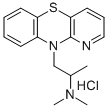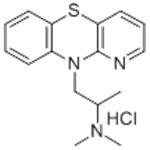Originator
Theruhistin,Ayerst,US,1957
Manufacturing Process
85 parts of phenylpyridyl amine, 21 parts of powdered sulfur and 1.7 parts of
iodine were heated to 275°C for two hours. Evolution of hydrogen sulfide
began when the mixture reached a temperature of 250°C and became
vigorous when it reached 275°C. Such evolution of hydrogen sulfide
diminished after about one hour at 275°C. A light oil was distilled from the
reaction mixture under vacuum (pressure = 2-3 mm Hg). This oil which
contained phenylpyridyl amine in addition to the thiophenylpyridyl amine was
then treated at boiling temperature with approximately the theoretical amount
of 2-3 normal HCl until complete solution resulted with formation of the HCl
salts of the amines. The solution was then treated with 1 to 2% (based upon
the substance mixture) of active carbon and then filtered hot. The nitrate was
then cooled to 0°C whereupon the thiophenylpyridyl amine hydrochloride
crystallized out while the phenylpyridyl amine hydrochloride remained in
solution. The thiophenylpyridyl amine hydrochloride was filtered off and
suspended in water and the pH adjusted with half concentrated ammonia to 8.
The thiophenylpyridyl amine set free was filtered off and dried. It was in the
form of gold yellow needles and had a melting point of 114°C to 115°C.
40 parts of thiophenylpyridyl amine were dissolved in 200 parts of water free
toluene. After the addition of 16 parts of soda amide, the mixture was
refluxed for 1% hours. Thereafter, 28 parts of dimethylaminoisopropyl chloride
in 30 parts of water free toluene were dropped in and the temperature
maintained at 20°C to 25°C for 30 minutes. Thereafter, the mixture was
heated at 60°C for 30 minutes and subsequently refluxed for 20 minutes.
Water and hydrochloride acid were then added to the reaction mixture and
this mixture rendered alkaline with NaOH and then the alkalized mixture
shaken out with ether. The dimethylaminoisopropyl-N9-thiophenylpyridyl
amine base thus obtained was vacuum distilled. It was then converted to
hydrochloride salt. The monohydrochloride salt is almost white in color and
melts at 213°C to 216°C. The yield was almost 100% of the theoretical.



